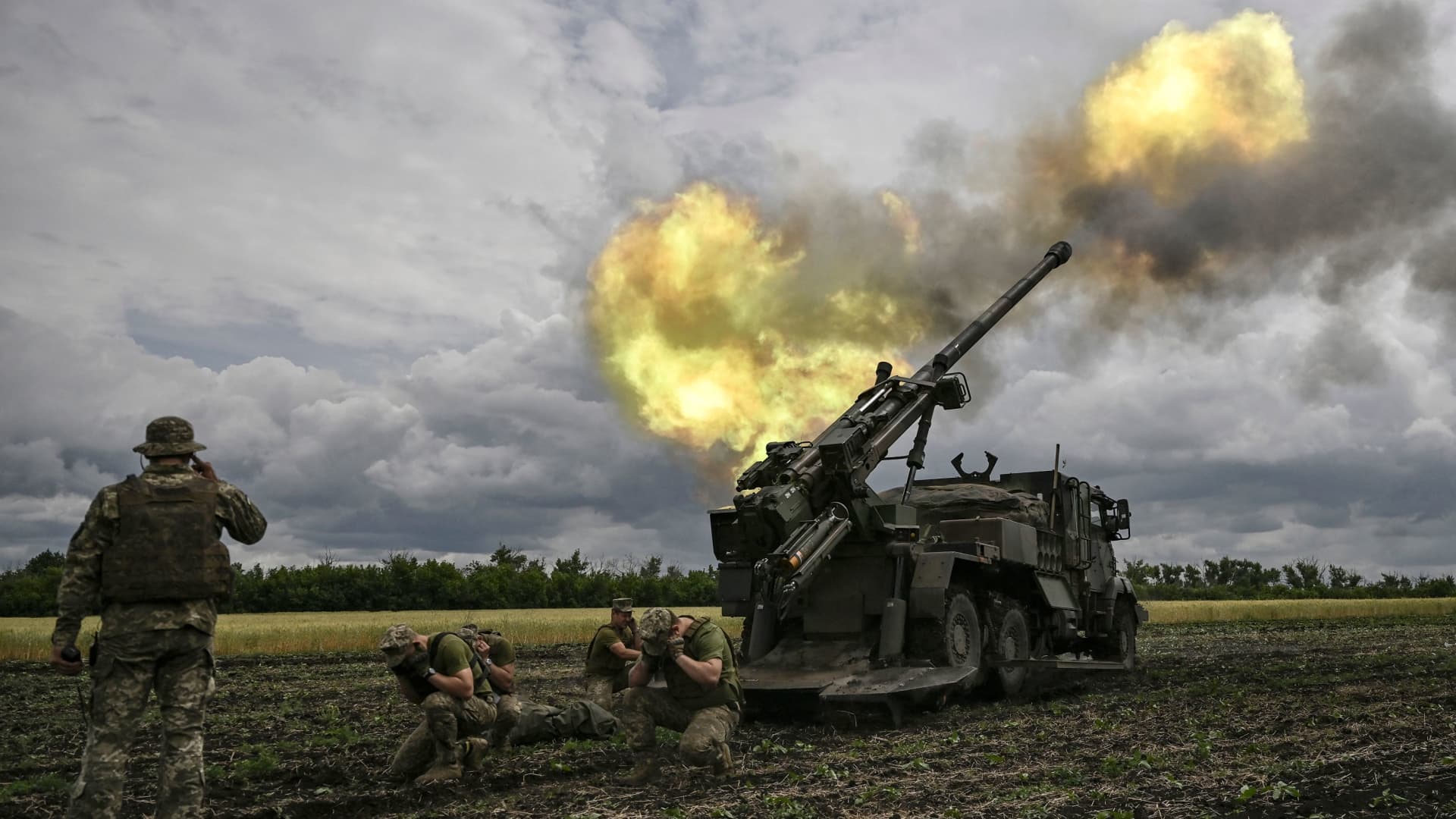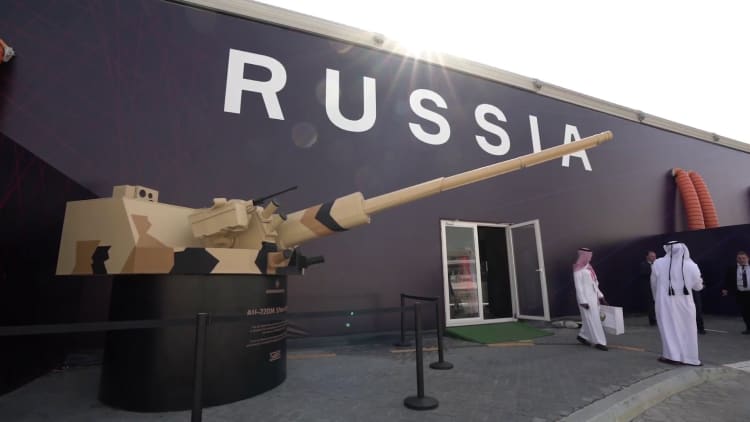
The 16th edition of International Defence Exhibition and Conference and the seventh edition of the Naval Defence and Maritime Security Exhibition in Abu Dhabi, United Arab Emirates, on Feb. 21, 2023.
Mohammed Zarandah | Anadolu Agency | Getty Images
Few things illustrate the health of the arms industry like a massive defense fair.
Over the last week, Abu Dhabi’s biennial international defense exhibition, known as IDEX, showcased a bustling sector. Decorated military personnel, government officials and weapons company executives mingled against the backdrop of giant missile and drone displays, while young men in terminator-like “smart armor” conducted battle simulations as fake explosions lit up massive LED screens.
Sprawling across enough land for a small town and drawing some 130,000 visitors from 65 countries, this year’s IDEX was the largest and most well attended in years.
It’s no secret why. Russia’s full-scale invasion of Ukraine one year ago jolted much of the industrialized world out of its comfortable status quo, in which a Western-led security order prevented major military invasions that Western powers did not want. Since that violent turning point in late February 2022, governments within NATO and outside of it have pledged to spend more on defense than ever.
“From our perspective, Putin is the best weapons salesman there is,” one American defense contractor at IDEX told CNBC, speaking anonymously as he lacked authorization to comment to the press.
“If Putin hadn’t picked a fight, then no one would be buying all this stuff.”
Indeed, many countries are ramping up their defense spending to unprecedented levels.

“With Russia’s invasion of Ukraine, many European nations have now committed to meeting or exceeding the NATO target — in some cases, years before they originally planned to do so,” an aerospace and defense report by McKinsey & Co. from December read. The crisis prompted “a review of long-standing assumptions that large-scale conflict on the continent was unlikely in the 21st century.”
Historic changes in military spending
Just look at Germany: It announced just days after Russia’s invasion that it would spend an additional 100 billion euros ($106 billion) on defense, a huge shift for a country that has skimped on military investment since the end of World War II.
Poland now aims to increase its defense budget to 3% of its gross domestic product in 2023. And French President Emmanuel Macron in early January announced his government’s plan to ramp up military spending by more than 30% in the coming years and prepare its armed forces for high-intensity conflicts. On top of that, U.S. military spending on Ukraine alone hit nearly $50 billion in the last year.
The big spending isn’t limited to the West. Russia in November announced a defense budget of roughly $84 billion for 2023 — that’s over 40% more than the originally planned figure for that year, which was announced in 2021.

And NATO ally Japan aims to double its defense spending to 2% of GDP by 2027, as regional threats from North Korea and China increase. China and Saudi Arabia also set respective records for their own governments’ defense spending in 2022, despite inflation, giving no indications of slowing down.
“Business is very good, unfortunately,” said an employee of a French drone manufacturer displaying at IDEX.
American arms companies seeing record orders
The U.S. arms industry is enjoying a windfall. U.S. military equipment sales to foreign countries shot up 49% to $205.6 billion in the last fiscal year, the State Department said in January.
America’s largest defense contractors, Lockheed Martin and Raytheon, received record orders. Lockheed’s net sales for the fourth quarter hit $19 billion, roughly 3% above its internal planning and up from $17.7 billion in 2021.
Ukraine was already stocking up on U.S.-made Javelins before Russia invaded. Pictured here a group of Ukrainian servicemen taking a shipment of Javelins as Russia positioned troops on Ukraine’s border.
Sergei Supinsky | AFP | Getty Images
Raytheon’s order backlog exceeded $150 billion last year and its fourth-quarter sales for its missiles and defense unit were up 6.2% to $4.1 billion. But the companies say they are hampered by supply chain issues and labor shortages, and that they would be seeing far higher sales numbers if it weren’t for those.
‘Depleted’ weapons stocks in Europe
For Europe, however, there is a genuine sense of urgency — after years of under-investment in the sector, reliance on the U.S. and now many months of sending their arms and ammunition to Ukraine, European nations need to prevent their own weapons stocks from being depleted entirely.
“The military stocks of most [European NATO] member states have been … depleted in a high proportion, because we have been providing a lot of capacity to the Ukrainians,” Josep Borrell, the EU’s high representative for foreign affairs and security policy, said in September.
“It’s becoming more and more urgent. There’s a lot more discussion, a lot more requests,” a manager at a British drone company said, requesting anonymity because of professional restrictions. When asked if demand for his company’s unmanned aerial vehicles was growing, he replied, “Astronomically.”
French multinational defense firm Thales is one of those in the private sector working to meet the needs of French and allied militaries whose supplies are running low.
“For sure the Ukrainian conflict forced us to increase our capacities,” Christophe Salomon, executive vice president for Land and Air Systems at Thales, told CNBC. His division focuses on radars, missiles, rockets, vehicles and other land systems.
“You have to increase your industrial footprint. You have to acquire your stocks. And we are talking about products where the lead time is around two years,” he said, describing the challenge of ramping up production when the supply chain for a single weapons system involves hundreds of different suppliers.
Ukrainian servicemen fire with a French self-propelled 155 mm/52-calibre gun Caesar toward Russian positions on a front line in the eastern Ukrainian region of Donbas on June 15, 2022.
Aris Messinis | AFP | Getty Images
Companies need government help to speed up the production process, Salomon said. France’s government has outlined measures in this direction, including simplifying military contracts and administrative procedures, pursuing import substitution for more French-made products, improving private-public partnerships and providing several billion euros worth of funding to replenish ammunition stocks.
France’s Caesar self-propelled guns, which have been highly effective in battle for the Ukrainian military, normally take two years to make; the government aims to cut that time in half.
Thales in May is delivering Ukraine its advanced GM200 radar system, which normally takes two years to make. Because of increased investment in its supply chain in the last year and advance buying of complex radar subsystems, Thales says, it can assemble Ukraine’s GM200 in four months.
“We speed up because our team works 24 hours a day,” Salomon said. “We took the responsibility to invest, we invest and we buy every subsystem before we know who will buy it.”
A Leopard 2 A6 heavy battle tank.
Sean Gallup | Getty Images News | Getty Images
Many in the Western defense sector complain that Europe’s largest economy, Germany, is still dragging its feet. Expanding its military footprint remains controversial and divisive in German politics, and Berlin has been clear that it wants to help Ukraine but avoid provoking Russia.
One German private sector attendee at IDEX described frustration at the pace of his government, but admitted that “because of history, it’s a bit problematic.” He requested anonymity to speak freely.
Germany’s major policy changes last year — most notably allowing its weapons to be used in foreign combat zones for the first time since World War II — make a major difference, the attendee said. “But,” he stressed, “we need to change our processes and move faster now.”
